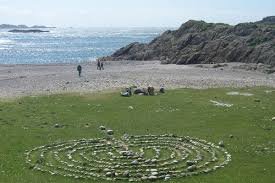Labyrinths
This week it was warm enough and dry enough for me to walk my favorite local labyrinth. It sits high on a hill overlooking Canandaigua Lake which brings joy as well as serenity to my visit. This labyrinth is made of well-groomed grass. I get the added pleasure of seeing clover blossoms with the occasional bee buzzing around as I walk it (in shoes and socks). The only place I like better is a labyrinth along a white sandy beach where I can walk barefoot.
Labyrinth, Iona, Scotland
I seldom pass up a labyrinth. I have walked a number in Ireland but also in Scotland, Norway, and Canada, too. The one on Iona in Scotland is pictured here. The one on the Arctic CIrcle was similar. While the Canadian one was created by a retreat participant trudging out a path in heavy snow to create the needed configuration. I made one from rope for an outdoor church service once, but with much less grace and ease. But the biggest flaw in my design was that the grass couldn’t get mowed until it was disassembled.
Perhaps, you have seen or used finger labyrinths. These are a great gift to someone convalescing. Also for coffee tables or waiting rooms. I have a laminated version with 2 large mirrored images of the design that I use for illustrations at workshops. You use the index fingers of both hands to simultaneously “walk” the labyrinth. It makes me aware of right brain/left brain functioning and clarifies things (after sometimes confusing them first. LOL)
A labyrinth is a form of pilgrimage. When you walk the labyrinth or even use a finger labyrinth, you are meant to think about your approach and then follow it through. The beauty of the labyrinth is you know you are safe. You know you cannot get lost. Yet, you get turned around at unexpected times. This is meant to free your mind from the mundane and give Spirit space to enter.
Rev. Lauren Artress of Grace Episcopal Church in San Francisco reintroduced many of us to this profound and simple spiritual practice with her book Walking the Sacred Path over twenty years ago. Her work re-legitimized labyrinths as an important Christian symbol. I remember visiting Chartre Cathedral after college and never noticing that the floor underneath the carpets and chairs hid a beautiful and most significant classic 11 circuit labyrinth complete with a rosette in the center, which is symbol of Mary. Rev. Artress is responsible for having that displayed again as well as for the trend for both indoor and outdoor labyrinths to be added to churches throughout the US.
The other well-known configuration is the ancient 7 fold, sacred geometry labyrinth that dates back to ancient times.


